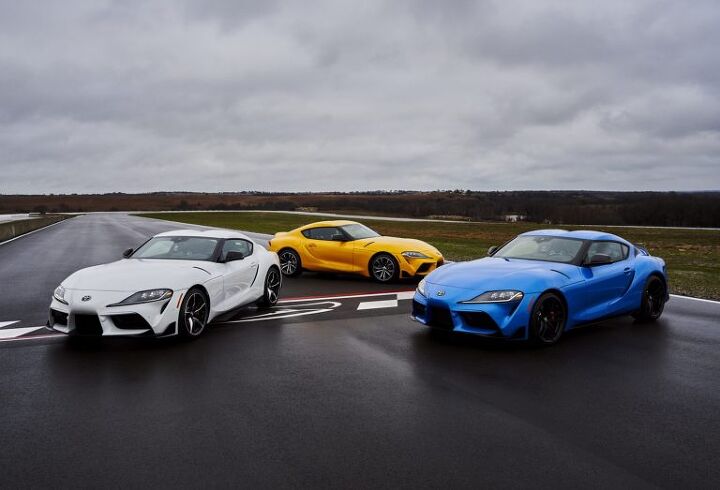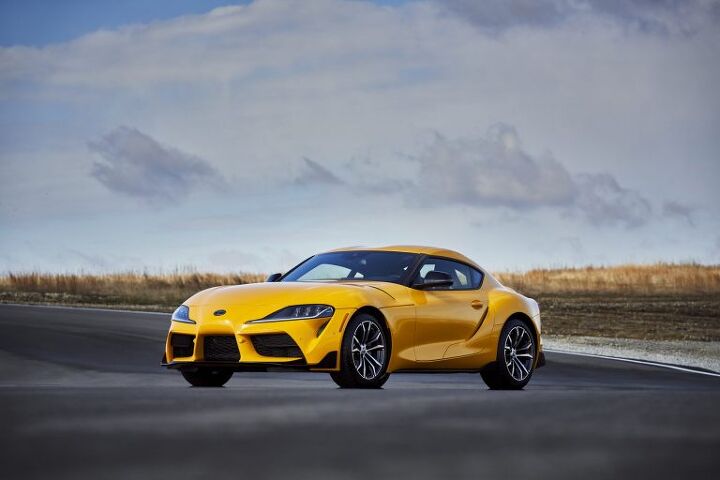2021 Toyota Supra: Japan Sends Four-cylinder Model to America, Beefs Up Straight-six

You’re going to feel like an idiot if you previously went out and purchased the new Toyota Supra, as the manufacturer decided to make some major improvements on the 3.0-liter inline-six for the 2021 model year — bumping up output, tweaking the suspension and adding some new options. It also decided to offer the 2.0-liter variant that was formerly prohibited from gracing our shores. And Toyota is upgrading the model’s standard equipment too, regardless of trim level, by swapping the 6.5-inch center display for an 8.8-inch screen.
But we want to make you feel as bad as possible, so let’s open with how much more horsepower the 2021 model makes when compared to the 3.0-liter GR Supra you bought last year (when dealer markups were impossible to avoid). Toyota has outfitted the twin-turbo BMW B58 with a redesigned exhaust manifold and new pistons that lower the engine’s compression. In itself, that’s not a recipe for a lot more power, but it sets the stage for Supra to endure higher turbo boost pressures and some meaningful factory tuning, resulting in 382 peak horsepower. That’s 47 more ponies than the complete garbage you took out a loan on last year, dingus.
Torque has crept up slightly, leveling off at 368 pound-feet (three more than in MY 2020). Power and torque curves have also been rejiggered, with peak power showing up slightly higher on the rev range — making it behave like a high-strung BMW Z4 M40i. The 3.0-liter GR Supra should noticeably faster than the Bimmer, however, with Toyota estimating 60 mph to arrive in 3.9 seconds. Top speed will remain electronically limited to 155 mph (which we know is lame).
The chassis has similarly been improved for 2021. There are new strut tower braces made from aluminum, retuned dampers, and fresh front and rear bump stops. Some factory tailoring was done to the car’s active rear differential, adaptive suspension and stability control. Electric power steering has also undergone a few changes, with Toyota saying the collective result is flatter handling and improved feedback to the driver.
One item that carries over is the default eight-speed automatic transmission found in all Supra models, including the new 2.0-liter variant that has been confirmed for North America. You’re probably already familiar with its engine because you can’t toss a rock into a BMW dealership without it hitting a car equipped with one. Toyota says it makes 255 horsepower and 295 pound-feet of torque in the Supra (and will also be limited to 155 mph).
While you’re probably more interested in the inline-six, the 2.0-liter turbo does come with some advantages. It’s said to be substantially lighter than its fancier brother at 3,181 pounds (the 3.0-liter weighs 3,397 lbs) and will undoubtedly be more affordable. Supra project lead Tetsuya Tada has even said the model would make an excellent project car, adding that the engine bay can accommodate the 2JZ. But so does a Fox-body Mustang if you buy the correct engine mounts and can endure being razzed by the occasional, unimaginative jerk.
Toyota worked hard to maintain the vehicle’s 50/50 weight distribution, though a few corners still had to be cut. The lesser model doesn’t have the six-cylinder’s active differential or adaptive suspension. It has crappier brakes, smaller 18-inch wheels, and fewer creature comforts inside the cabin (manual seats, for example). But this also makes it ideal for extensive customization, not to mention for those who’d like a Supra for less than $50,000.
As previously stated, all trims now get the 8.8-inch infotainment touchscreen that was optional last year by default. Toyota is now offering a Safety & Technology package that adds stuff like adaptive cruise control, parking sensors, navigation, wireless Apple CarPlay and an upgraded sound system.
Both 2021 Supras should arrive at American dealerships this June, with pricing to be announced closer to launch. The straight-six version shouldn’t stray too far from last year’s price, though we’re eager to see how low Toyota can go with the 2.0-liter turbo.
There will also be a limited-run A91 Edition (capping at 1,000 units) offering an exclusive blue paint scheme, carbon fiber accenting on the exterior, raised ducktail spoiler, black wheels, some stripes on the c-pillar, and its own interior with blue stitching. The GR Supra GT4 (not pictured) follows in August, offering 430 hp and the lightest curb weight of any Supra variant. It’ll be the only model to come with its own seven-speed sports automatic transmission, and comes with a mechanical limited slip differential, a racier suspension, six-piston brakes (four-piston rear), Akrapovič exhaust system, FIA-standard racing seat with six-point harness, roll cage and everything you else you’d expect on a factory racer.
[Images: Toyota]

A staunch consumer advocate tracking industry trends and regulation. Before joining TTAC, Matt spent a decade working for marketing and research firms based in NYC. Clients included several of the world’s largest automakers, global tire brands, and aftermarket part suppliers. Dissatisfied with the corporate world and resentful of having to wear suits everyday, he pivoted to writing about cars. Since then, that man has become an ardent supporter of the right-to-repair movement, been interviewed on the auto industry by national radio broadcasts, driven more rental cars than anyone ever should, participated in amateur rallying events, and received the requisite minimum training as sanctioned by the SCCA. Handy with a wrench, Matt grew up surrounded by Detroit auto workers and managed to get a pizza delivery job before he was legally eligible. He later found himself driving box trucks through Manhattan, guaranteeing future sympathy for actual truckers. He continues to conduct research pertaining to the automotive sector as an independent contractor and has since moved back to his native Michigan, closer to where the cars are born. A contrarian, Matt claims to prefer understeer — stating that front and all-wheel drive vehicles cater best to his driving style.
More by Matt Posky
Latest Car Reviews
Read moreLatest Product Reviews
Read moreRecent Comments
- Formula m How many Hyundai and Kia’s do not have the original engine block it left the factory with 10yrs prior?
- 1995 SC I will say that year 29 has been a little spendy on my car (Motor Mounts, Injectors and a Supercharger Service since it had to come off for the injectors, ABS Pump and the tool to cycle the valves to bleed the system, Front Calipers, rear pinion seal, transmission service with a new pan that has a drain, a gaggle of capacitors to fix the ride control module and a replacement amplifier for the stereo. Still needs an exhaust manifold gasket. The front end got serviced in year 28. On the plus side blank cassettes are increasingly easy to find so I have a solid collection of 90 minute playlists.
- MaintenanceCosts My own experiences with, well, maintenance costs:Chevy Bolt, ownership from new to 4.5 years, ~$400*Toyota Highlander Hybrid, ownership from 3.5 to 8 years, ~$2400BMW 335i Convertible, ownership from 11.5 to 13 years, ~$1200Acura Legend, ownership from 20 to 29 years, ~$11,500***Includes a new 12V battery and a set of wiper blades. In fairness, bigger bills for coolant and tire replacement are coming in year 5.**Includes replacement of all rubber parts, rebuild of entire suspension and steering system, and conversion of car to OEM 16" wheel set, among other things
- Jeff Tesla should not be allowed to call its system Full Self-Driving. Very dangerous and misleading.
- Slavuta America, the evil totalitarian police state










































Comments
Join the conversation
I'm still confused about this car. Toyota is a first tier car maker with a massive financial footprint. They can afford to design and build a limited production car. While BMW is also first tier, I don't get why Toyota buys from them....it's not a Toyota, its a BMW. That's ok...but like the Saab 9-2 was a Subaru, not a Saab. They aren't making a Supra, as in a special car that Toyota can be proud of as a corporate symbol....
I still have yet to see one of these ANYWHERE in person and I live in a major metro area of 2.5 million. I'm also a bus driver, to boot so I see a LOT of cars. I don't see them at Toyota dealers, I don't see them on the road and I don't see them at Cars & Coffee. I honestly think this thing is a just a figment of our imaginations.